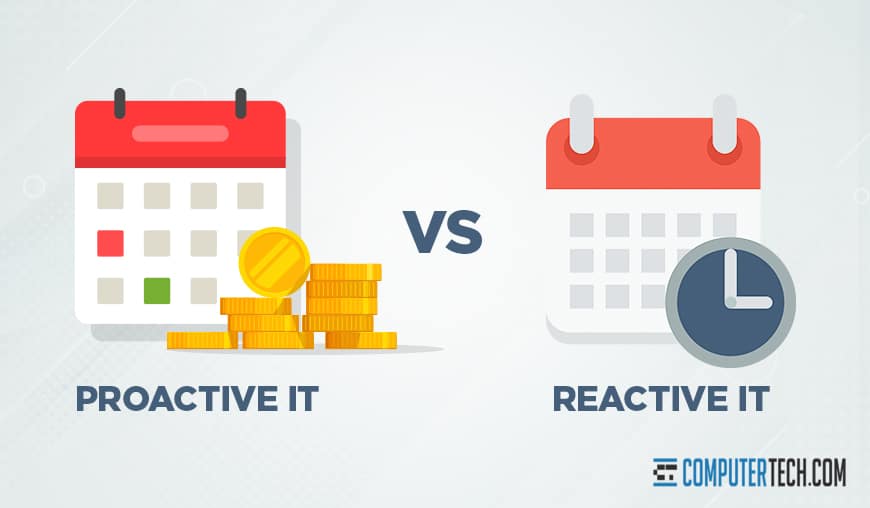-

Information technology is a field that requires a great deal of knowledge and a strategy that allows your team to neutralize threats successfully. Developing these strategies is a highly involved process and can help to reinforce protection against hacking attempts and other digital hazards. However, the wait-and-see approach can leave systems vulnerable with little chance of fending off these attacks.
When establishing protocols for fighting against these issues, you might be more interested in developing a proactive IT strategy. With technology being susceptible to outside hacking attempts and simple breakdowns in commonly used processes, making sure you can get ahead of the issue is the best call.
Proactive IT vs. Reactive IT
There are two major ways to go about it when it comes to developing your company’s information technology strategy. There is a proactive approach and a reactive one that affects how an IT system is set up and how the practices are maintained and executed when an issue arises. The most popular IT strategy is the reactive strategy employed by most major companies, but that does not necessarily make it ideal.
Like you might imagine, a reactive IT strategy is based on minimizing the cost of maintaining information technology needs and reacting to situations that arise. It comes about because a reactive strategy views IT as an expense with only minimal return on the overall profit for the business. To that end, they save on costs by retaining the services of IT professionals on an as-needed basis. In essence, they only seek IT professionals when a problem has already presented itself or on a scheduled renewal to make sure the machines remain functional. However, the central issue is that these errors can occur at any time, and not having a full-time IT department or firm on retainer can cause the issues to become more severe because they cannot be addressed quickly enough.

A proactive strategy is the exact opposite of all of that. Instead of viewing IT as an expense to be written off whenever possible, it is viewed as an investment designed to keep the machines in your office up and running at peak efficiency. To ensure that the investment pays off, a proactive strategy involves maintaining a full-time IT department or outsourcing to an IT firm that remains on retainer for your technical needs. So, rather than wait for issues to arrive that force you to seek out assistance on the fly or overhaul your system entirely to avert disaster, you instead have IT talent available as soon as you need it without delay.
Retaining a reactive or proactive approach to information technology is about retaining the services of an IT department and how you go about maintaining certain pieces of equipment in the office, and what kind of schedule you replace them. Ultimately, a reactive strategy leaves most companies at an overall disadvantage compared to those with a proactive strategy.
Unfortunately, even though proactive strategies are more effective, 90% of approaches to information technology needs are reactive rather than proactive. However, there is a reason maintaining a proactive approach is more effective. But you don’t have to take our word for it; here are the benefits.
It Affects Your Budget
How much did you spend on your last IT overhaul? Was it more expensive than the time before it? A reactive IT strategy is more expensive to a company in the long run since you are not actively preparing for the effort it takes to get everything functioning. In addition, the cost of maintaining the technology in your office does not go away, and you need to brace for it. With a reactive IT strategy, the costs of IT management are not a cost that is prepared for but is done when the need becomes too great to continue ignoring.

On average, American companies allot approximately 3% of their total revenue towards IT costs as of 2020. If the cost is something you have not prepared for, that 3% can be a devastating hit to your overall revenue and cost you in the long term. Comparatively, a proactive strategy involves establishing an annual budget for IT expenses that allow you to retain a pool of funds to use on IT costs such as paying for services, replacing devices, overhauling systems, or what have you. Ideally, you should establish a budget that can span multiple years instead of a single year, but this may not always be the case, depending on the company’s size.
Having a proactive approach to IT in regard to your spending habit is important because it allows you to prepare for problems ahead of time, and it is simpler to implement protocols. On the other hand, a reactive strategy would have you scrambling to find the funds you need in the way that least impacts the overall flow of money in your organization.
It Prevents Your Equipment From Failing
Information technology relates to both software and hardware since neither one is useful without the other to make it function. However, all technology suffers from rapid onset obsolescence, with computers being exceptionally vulnerable to such an issue. This obsolescence means that devices your company uses that date back even five years can be considered antiquated by contemporary standards as new models of computers and components come out to advance the standard.
The older the technology is, the less effective it is, as older machines that have more worn-out parts will operate slower compared to newer machines. This ineffective operation can result in employees being unable to complete their tasks quickly and can put a company way behind where they are meant to be. The overhaul of devices and software in the office falls under the purview of IT services, so if you are letting old machines sit and use them until they are worn into the ground, you will find yourself in an office full of machines too slow to be effective.

Upgrading systems on a last-resort basis is a reactive strategy that can make working challenging for your employees. There is nothing more frustrating than trying to complete a task and sitting staring at a screen for several minutes as it struggles to load the information.
With a proactive strategy, components in computers that are wearing out or computers themselves can be replaced piecemeal so that you do not have to pay for it all at once. Additionally, making sure your machines are updated will allow your employees to work more effectively and minimize their urge to hurl their computers out the window. Overhauls can also be necessary for computers that have antiquated software that might be gumming up the works. While an IT department or firm will not be able to replace hardware, many will help install it.
It Averts Security Issues
Cybersecurity is a significant component of modern information technology. In fact, it is one of the most important parts since it regulates the protection of the information your company handles. Cybersecurity, much like the hardware and software you use, is an ever-shifting part of the technological world as more vulnerabilities are discovered in software that can be exploited. New techniques are used to combat these new methods of cyberattack. If you have a cloud system, server, or any kind of data storage, you are at risk of cyberattack without the appropriate protection.
In a reactive environment, most people remain true to their inherent security and do not perform upgrades of any kind until a virus or attack successfully plagues your system. At which point, your initial safeguards might be effective at preventing the spread but might result in some data loss without intervention. The protection reactive IT strategies employ is not ineffective by any means and can be very useful in ensuring that data is protected.
However, without regular upgrades and attention paid to new cybersecurity trends, your security can rapidly become obsolete. In addition, in the event of a live cyberattack, you are reliant on automated systems rather than intervention from a cybersecurity professional trained in countering hack attempts and possibly even finding information that can lead to identifying the source of the attack.

With a proactive approach, cybersecurity becomes a more assured part of your IT needs. Depending on the kind of department you staff or facility you outsource your IT needs to, you will have direct access to professionals. These professionals will not only be able to actively update the security measures surrounding your company data but help plan ways to implement more advanced methods to prevent attacks and take advantage of new techniques to reinforce security. In some cases, they can even staff specialists who handle attempts to counter hack attempts directly to minimize damage.
Given that ensuring data security is one of the most critical responsibilities any company has, ensuring you have the best odds of doing so is in your best interest for your IT needs. So, more often than not, employing a proactive strategy is more effective for IT protocols.
What a Proactive Strategy Entails
Implementing a proactive IT strategy is not as complicated as it sounds and is not necessarily something you will have to manage on your own. Establishing a fully proactive IT strategy generally boils down to 24/7 or near 24/7 service on all information technology needs you might have. For example, suppose you are staffing your own IT department within your company. In that case, this means being able and willing to pay your staff accordingly and having them establish the services when the server and devices are being actively used.

In either case, once a proactive IT strategy is employed, you will enjoy a workplace with full support for technical issues you face as you work. Issues can be resolved in real-time, using real-time network monitoring and patching to prevent security or functionality problems. Regular auditing by professionals preemptively rather than waiting until an issue arises that needs fixing. A proactive IT strategy means that when an issue does arise, it is dealt with quickly and in real-time rather than becoming a ticket that will be addressed after older issues are addressed first.
The best part is that you do not have to staff an in-house IT department if that is something beyond what you are able or willing to commit to. Instead, outsourcing IT needs to a dedicated firm will grant you the proactive IT strategies you need. In New Jersey alone, skilled firms offer dedicated IT services that help maintain the technology in your office and provide real-time support inherent in proactive strategies.
Wrapping Up
Reactive and proactive IT strategies are two styles of maintaining your technology and software that clash with each other. The former has its merits but is not as effective as it once was as our reliance on technology and the subsequent improvements are made. A proactive strategy will allow you to maintain your system in real-time and receive the support you need when it is needed to minimize the downtime you and your employees experience when there is an issue. There are too many people in the world who are happy to steal information they have no right to access. So, a proactive approach will also help to keep that data safe from those individuals.
At the end of the day, the type of strategy you employ is determined by the resources available to you. If it is not feasible for you to staff a full-time IT department, outsourcing is your best bet. If you do not have the resources to employ a proactive approach, then a reactive one will serve as a sufficient stopgap. However, you should definitely move to a proactive approach as soon as the resources present themselves. But your odds are at their peak when outsourcing for the IT services you need for a proactive strategy that will minimize your overall costs.

If you or your business have any questions regarding your IT strategy or outsourcing in general, please feel free to reach out at any time! We’d be more than happy to assist with any of your IT needs.
About The Author
Herman
Herman is the lead team member here at Computertech.com. He’s been in IT for over 20 years and has expertise in our various IT Services including Microsoft Azure, Microsoft 365, Microsoft Teams and even Computer Security.
No related posts.
IT Support | IT Services | IT Consultant | Computer Support
Speak to a Human (856) 347-2282
- Home
- About Us
- Services
- IT Support
- Managed IT Services
- IT Consulting and Strategy
- IT Security Services
- IT Infrastructure Services and Networking
- Help Desk and Onsite Support
- Communication and Collaboration
- Specialist IT Services
- Data Backup and Disaster Recovery
- Cloud Computing
- Optimizing Network Consulting Services
- Remote Monitoring and IT Management
- Business Computer Services and Consulting
- Blog
- Contact Us
Navigation- Home
- About Us
- » About Computer Tech
- » What To Expect
- Services
- » IT Support
- » Managed IT Services
- » IT Consulting and Strategy
- » IT Security Services
- » IT Infrastructure Services and Networking
- » Help Desk and Onsite Support
- » Communication and Collaboration
- » Specialist IT Services
- » Data Backup and Disaster Recovery
- » Cloud Computing
- » Optimizing Network Consulting Services
- » Remote Monitoring and IT Management
- » Business Computer Services and Consulting
- Blog
- Contact Us
What is a Proactive IT Strategy and Why Do You Need One?
In need of IT Services or IT Support? Call us today at (856) 347-2282
About Us
Computer Tech is an IT Consultant \ Computer Consultant firm providing Computer Support, IT Support and IT Services in South Jersey, IT Services Delaware, IT Services New Jersey, Philadelphia Pennsylvania.
(856) 347-2282Get started:
- 6 Things to Try if Your Work Laptop Won’t Boot Up
- The Ultimate Guide to IT Companies in New Jersey
- What is a Proactive IT Strategy and Why Do You Need One?
- How to Recover Data From a Broken Company Computer
- How NJ Businesses Are Outsourcing Their CIO and CTO Roles
- 8 Benefits of Using a Local New Jersey IT Company
- The Benefits of Managed IT Support Services for Businesses
- How Outsourced IT Support Can Help Employees Working Remotely
- [Guide] What Exactly Does an IT Support Company Do?
- Onsite IT vs Remote: How to Choose the Best for Your Business
Newsletter
Computer Tech, LLC.
105 Market Pl Suite 1, Glassboro, NJ 08028
(856) 347-2282
© Copyright 2025 HighTech Business Solutions. All Rights Reserved.



